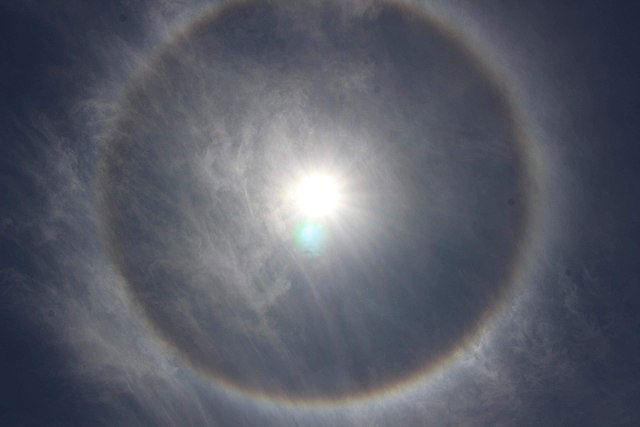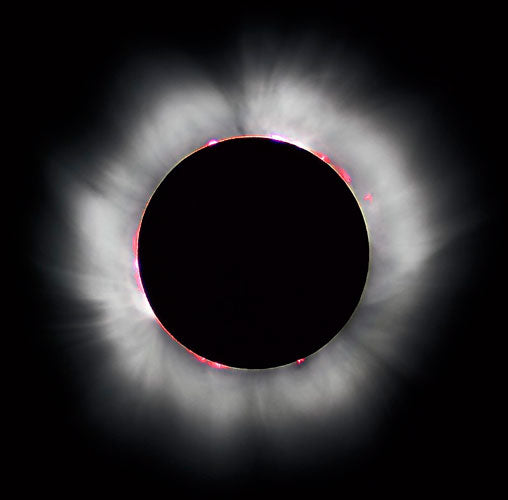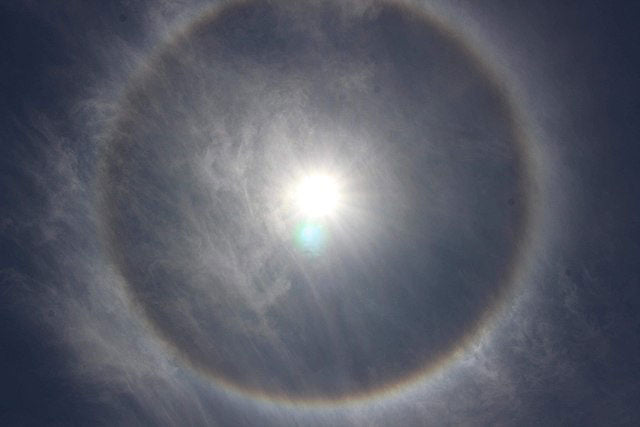
Have you ever looked at the sky and noticed that there is a faint rainbow wrapped around the Sun? This is an optical phenomenon known as a solar halo, and it can be a marvelous sight to behold! But did you know that there are several different types of these halos, and each one has its own unique characteristics and causes?
Let’s take a look at what causes these halos in the first place, the different types of halos that occur, and explore ways you can study these amazing events even further.
What Causes Solar Halos?
So, what causes solar halos? You may be surprised to learn that the answer is ice crystals! When the weather conditions are just right, ice crystals become suspended in the upper atmosphere, typically within cirrus, or wispy, clouds.
When sunlight hits these ice crystals, light is reflected, refracted, and dispersed through the prism of the crystal, where it is bent at a 22° angle. This separates the light into its individual colors of the spectrum –– the same principles of light behavior which cause traditional rainbows to occur after a rain shower. As with rainbows, these halos are all about the position of the observer (you) to the light source.
Before modern meteorology, these halos were considered leading indicators of an impending rainfall; the cirrus and cirrostratus clouds which cause the halos often signal a frontal system on the horizon.
Different Types of Halos

There are a few different types of solar halos that you can observe, but let’s take a look at some of the most common. In addition to the standard circular halo –– known as the 22° halo –– there are also sun dogs and light pillars
Sun Dogs are bright spots that occur on either side of the Sun –– to the left, right, or both. These are most commonly observed when the Sun is close to setting along the horizon, and when ice crystals are closer to the ground (rather than floating in the upper atmosphere). In this instance, the ice crystals are referred to as ‘diamond dust’.
Light Pillars are another type of optical phenomenon that produces a vertical beam of light near the Sun. These are typically caused by flat, hexagonal ice crystals that fall through the sky like flakes. As those flat crystals fall, sunlight is reflected vertically through them, thus creating the telltale ‘pillar’.
Solar Halos During an Eclipse

There is another type of solar halo that occurs during an eclipse, one which has to do with the Sun’s corona. The corona, which is Latin for ‘crown’, is the gaseous outer atmosphere of the Sun. Although it is always hanging around the surface of the Sun, we normally cannot see it due to the brightness of the Sun’s light.
A solar eclipse halo occurs during a total solar eclipse, during the moments when the Moon passes in front of the Sun. When the Moon blocks the circumference of the Sun, thus blocking out the light being emitted by the Sun, the corona becomes visible. This halo appears as a hazy white cloud surrounding the blacked-out Sun.
Scientists use total solar eclipses as an opportunity to study the Sun’s atmosphere, from the temperature of the surrounding atmosphere to the intensity of the radiation it produces. These observations can help us gain a better understanding of the Sun’s behavior, including its impact on space travel and communication systems here on Earth.
What Causes Lunar Halos?
The Sun isn’t the only celestial body that gets to have all the fun. The Moon is capable of producing a lunar halo, too! The basic principles involved are the same: ice crystals trapped in high altitude cirrus clouds reflect, refract, and disperse the light coming off of the Moon. That is why you are more likely to observe a lunar halo during colder months and around the time of a full moon, when the light being reflected by the Moon is brightest.
Continue Your Study of Halos
If solar halos have piqued your interest and you would like to continue your study of light, refraction, and rainbows, consider picking up a pair of diffraction glasses. Our plastic diffraction glasses are an affordable way to continue your exploration of light, halos, and rainbows, and can help bring your lesson plan to life in a way that students will never forget.
If you’re planning on experiencing a total solar eclipse in the near future to catch a glimpse of a solar eclipse halo for yourself, you’ll want to be prepared. We have a wide selection of eclipse viewing equipment, including a variety of solar eclipse shades, solar eclipse viewers, and solar filters for cameras and telescopes. All of our eclipse gear is CE Certified, meets the standard for ISO 12312-2:2015 and the transmission requirements of scale 12-16 of EN 169/1992 for truly safe direct solar viewing.
Discover the Wonder
Discover the wonder of solar halos for yourself, from circular halos and sun dogs to light pillars and solar eclipse halos. If you have any questions about the diffraction glasses or the eclipse gear you need to further your education, don’t hesitate to get in touch. Contact Rainbow Symphony by phone at 818-708-8400, or by email at rainbowsymphony@rainbowsymphony.com




